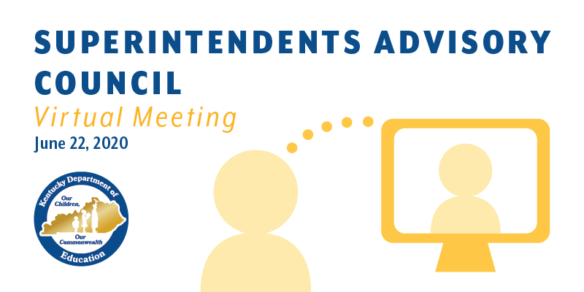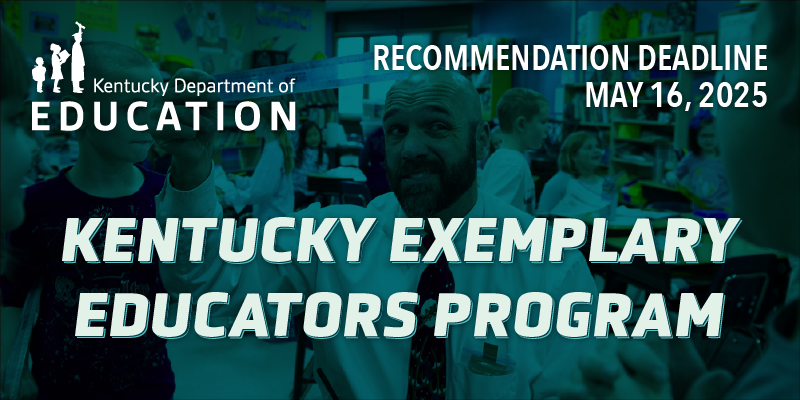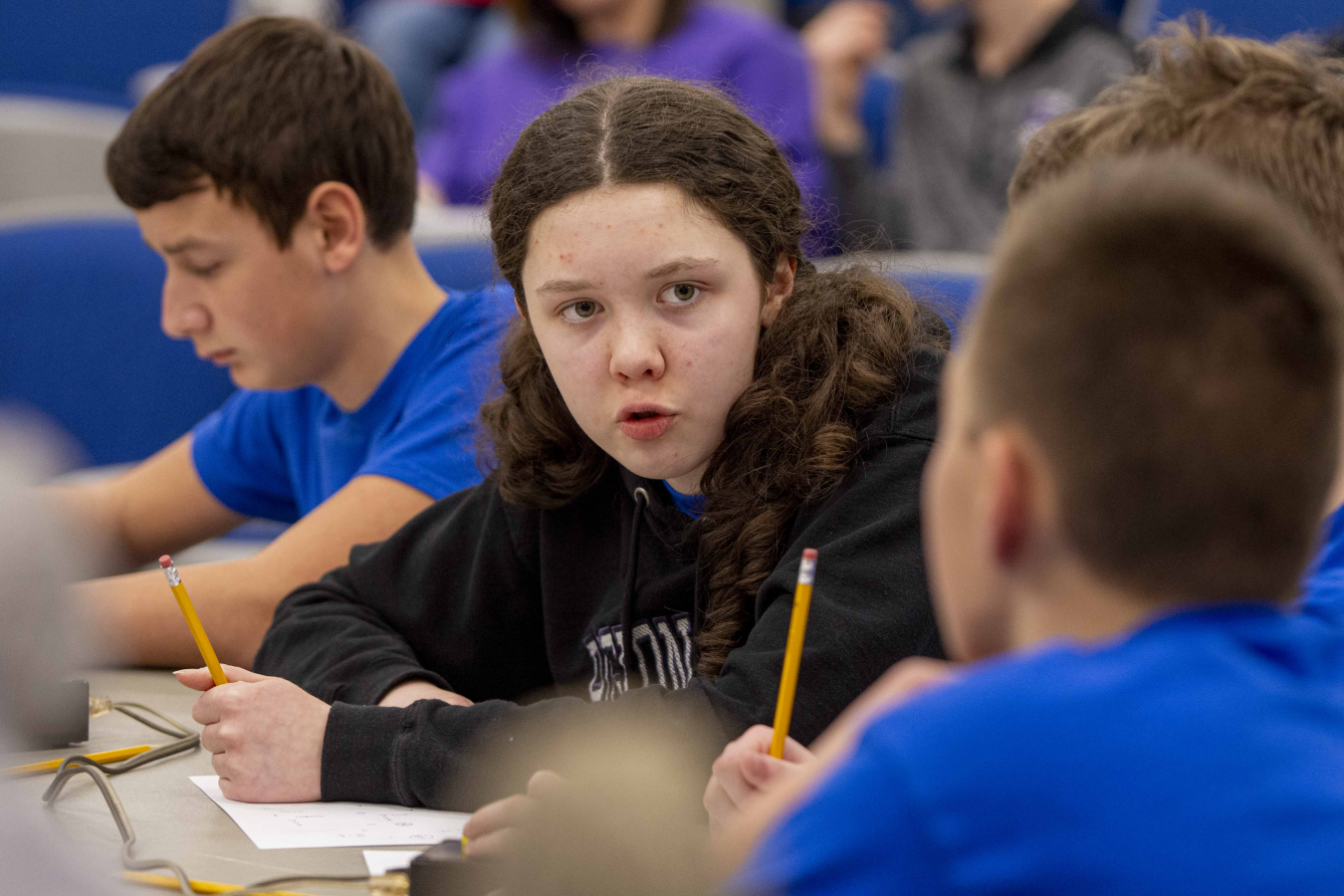
- Interim Education Commissioner Kevin C. Brown informed the district leaders that the highly anticipated Healthy at School guidance will be released by Gov. Andy Beshear during his June 24 press conference at 4 p.m. ET.
- As districts begin to plan their instructional method for the 2020-2021 school year, Associate Commissioner Robin Kinney of KDE’s Office of Finance and Operations told the SAC that she does not want them letting funding influence their decisions.
By Jacob Perkins
Jacob.perkins@education.ky.gov
The Kentucky Department of Education’s (KDE) Superintendents Advisory Council held its virtual meeting on June 22 and much like previous advisory council meetings convened by the department, the primary focus remained on reopening schools in the fall.
Interim Education Commissioner Kevin C. Brown informed the district leaders that the highly anticipated Healthy at School guidance from the Kentucky Department of Public Health (DPH) will be released by Gov. Andy Beshear during his June 24 press conference at 4 p.m. ET.
Brown was joined by Dr. Connie White, deputy commissioner of DPH, to listen to feedback from the council on how districts are preparing to implement reopening plans once the Healthy at School guidance document is released.
“Our goal here is to work with our other partnering agencies across the state and in state government, and working with you to provide you the support you need to reopen schools safely and also to do it in a way that is responsive to the needs of your community,” Brown said to the SAC members.
Much of the conversation with White revolved around DPH’s recommendation that schools require both faculty and students to wear masks when in the school building and when social distancing is not possible.
As more studies on COVID-19 become available by the Centers for Disease Control and Prevention and other reputable sources, it has become clear that masking may be the best way to mitigate the spread of the virus, said White.
“It is the one thing that we can do, and I think if we have our education leaders see that as an expectation … and model that, it’s going to make that harder for students (to not wear masks),” she said.
Todd Allen, interim general counsel for the Kentucky Department of Education, said schools will need a clear policy or procedure for how to respond when a student refuses to wear a mask.
“We certainly wouldn’t physically force a mask on any student,” he said, adding that teachers and staff will need to know how to respond from their local districts.
Brown said he understands the difficult decisions superintendents will have to make when it comes to safely reopening schools.
“One of the things we’re facing is our society expects and backs up school leaders for students to have shoes on. Our society expects and backs up school leaders for students to keep their shirts on during school,” Brown said. “And so it’s generally not a problem to keep shoes and shirts on kids because our society backs that up. The problem we’re having right now is … we don’t have a societal expectation of wearing a mask, unfortunately.
“And it’s to some degree starting to become a divisive issue in our communities. And so that really is placing school leaders in a conundrum.”
White added that countries that previously mandated the use of masks have seen drastic decreases in the number of COVID-19 cases.
While it will be the expectation of DPH to ensure students and faculty are masked, there are exceptions for students who have heart conditions, asthma or other underlying conditions.
White recommends that districts utilize the medical records of students to determine when a student cannot be masked in the school.
“There are certain people with certain conditions who can’t wear masks,” she said. “ … We already know who those folks are. People aren’t going to suddenly develop an asthma condition so they don’t have to wear a mask.”
Brown told the superintendents on the council that it will be a “statewide effort” to support mask-wearing until a vaccine is made available. Dr. Steven Stack, commissioner of DPH, previously stated during the May 27 Special Superintendents’ Webcast a vaccine will not be available until at least 2021.
“We know you can’t have a mask on every child at every minute,” said Brown. “Public health has recognized that in their guidance.”
Brown recommended that districts use best effort while determining when it is feasible for a student to wear a mask and when it is not.
The Healthy at School guidance document from DPH will recommend that students and faculty distance themselves at a minimum of 6 feet. If this distance cannot be achieved, they will be expected to wear masks.
Woodford County Superintendent Scott Hawkins explained that, at least with his district, it will be “next to impossible to do 6 feet apart in a classroom” and that districts “will be shocked at the number of people who won’t send their kids back if they have to wear a mask for six or seven hours a day.”
“To think that we can have school with every classroom at six feet apart is just not feasible,” he said. “I don’t think I’m alone in that. I just don’t see that being a realistic possibility.”
With guidance from DPH, districts will be able to develop a reopening plan that could address these concerns from families, Brown said.
Franklin County Superintendent Mark Kopp said his district is considering a phased-in approach. Phase one would be 100% online during the first nine-weeks of school. One day per week during this phase, students could voluntarily come to school to seek assistance on instruction.
Kopp said the available days in the week would be spaced apart to limit the number of students coming into the school buildings. After fall break, the district would enter phase two, which would be a hybrid approach. In a hybrid model, students would have both in-person and online instruction.
“That is one reason why … we very much felt from the state level that we have local control,” said Brown. “ … Even from a district and county to county, there can be differences in what the community wants in your reopening plan.”
Participation and Funding
As districts begin to plan their instructional method for the 2020-2021 school year, Associate Commissioner Robin Kinney of KDE’s Office of Finance and Operations told the SAC that she does not want funding to influence their decisions.
When determining their 2020-2021 Support Education Excellence in Kentucky (SEEK) funding – the primary funding source for districts – districts were allowed flexibility from the passage of SB 177 (2020) to choose whether they wanted to submit their 2018-2019 or 2019-2020 school year attendance data for calculations. Kinney said 14 of Kentucky’s 172 public school districts decided to use their 2019-2020 data for 2020-2021 funding purposes, feeling that this data was an accurate portrayal for their district.
“It is our recommendation that we move forward with what was in SB 177,” said Kinney. “So attendance and funding will be taken care of for the next school year.”
Kinney said that instead of counting attendance next school year, districts will need to count participation.
If students are in the classroom, participation will be counted if they are present. If the school is utilizing remote learning, participation can be counted by logging in to their device or similar methods.
“The other piece that we could still use your input and help with is how to really capture that participation by students who do not have the full access to technology,” said Kinney.
Kinney encouraged the superintendents to continue to pursue technological opportunities for these students, but said it may not be possible to provide for every student.
Kenton County Schools Superintendent Henry Webb said his district used participation logs in the spring, but added that this idea could be enhanced by adding a completion of assignment log.
“Each student who completes the assignments, that work could be gathered for each student to have that as supporting documentation,” he said.
Kinney said the plan would be to provide a participation report to the Legislative Research Commission at the end of the school year to show the participation by Kentucky’s school districts.
Brown said KDE will issue a memorandum, subject to the approval of Lt. Gov. and Secretary of the Education and Workforce Development Cabinet Jacqueline Coleman, and recommend an emergency administrative regulation to the Kentucky Board of Education that will determine how participation and funding will be counted if Kentucky continues forward with an adjusted opening in which schools reopen with staff shortages or social distancing measures that impact capacity, or with the possibility of some schools being unable to reopen.
“You can bank on the fact that you’re going to have an alternative way that we can flow funding to you for this next school year because of this unique situation,” said Brown.
Brown said that the next school year could be used as a “conversation starter in the next General Assembly about the future of education funding.”
“We will have a small taste of a little bit of an alternative because of next semester and the unique challenges,” he said. “But, obviously, long-term it would take action from the General Assembly to change the overall SEEK formula.”
The SAC is scheduled to meet again on July 20, but may meet on July 6 to discuss the Healthy at School guidance document.
Previous coverage of the Superintendents Advisory Council
- Superintendents Advisory Council reconvenes to discuss 2020-2021 attendance amid COVID-19 pandemic (June 8, 2020)
For more information about COVID-19:
- Kentucky Department for Public Health’s COVID-19 webpage
- KDE’s COVID-19 webpage
- COVID-19 Hotline (800) 722-5725




Social distancing and masks okay, what about handwashing? EVERY child should wash their hands before eating or school snacks. They should have done this in the past, pre covid and MUST do it now! When schools see the first sign of rampant illness, they need to close a day or two and do a massive cleaning. Programs for perfect attendance should be stopped. This encourages sick kiddos to come to school.